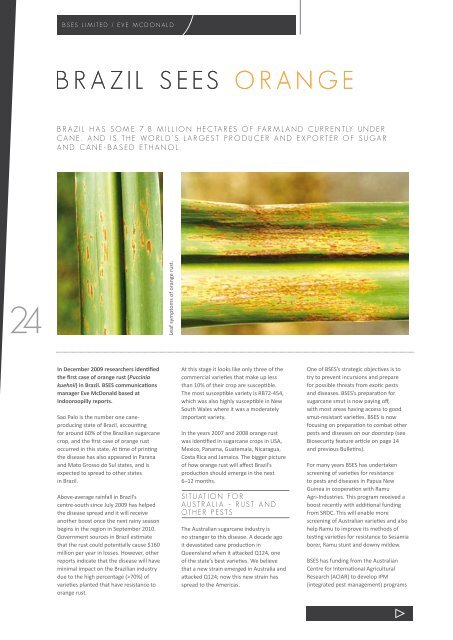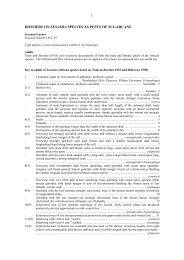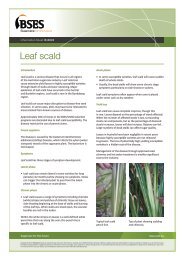You also want an ePaper? Increase the reach of your titles
YUMPU automatically turns print PDFs into web optimized ePapers that Google loves.
24 leaf<br />
Bses LiMiTeD / eve MCDONALD<br />
BrAziL sees OrANGe<br />
BrAziL hAs sOMe 7.8 MiLLiON heCTAres Of fArMLAND CurreNTLy uNDer<br />
CANe, AND is The WOrLD’s LArGesT prODuCer AND expOrTer Of suGAr<br />
AND CANe-BAseD eThANOL.<br />
In December 2009 researchers identified<br />
the first case of orange rust (Puccinia<br />
kuehnii) in Brazil. <strong>BSES</strong> communications<br />
manager Eve McDonald based at<br />
Indooroopilly reports.<br />
Sao Palo is the number one caneproducing<br />
state of Brazil, accounting<br />
for around 60% of the Brazilian sugarcane<br />
crop, and the first case of orange rust<br />
occurred in this state. At time of printing<br />
the disease has also appeared in Parana<br />
and Mato Grosso do Sul states, and is<br />
expected to spread to other states<br />
in Brazil.<br />
Above-average rainfall in Brazil’s<br />
centre-south since July 2009 has helped<br />
the disease spread and it will receive<br />
another boost once the next rainy season<br />
begins in the region in September <strong>2010</strong>.<br />
Government sources in Brazil estimate<br />
that the rust could potentially cause $160<br />
million per year in losses. However, other<br />
reports indicate that the disease will have<br />
minimal impact on the Brazilian industry<br />
due to the high percentage (>70%) of<br />
varieties planted that have resistance to<br />
orange rust.<br />
symptoms of orange rust.<br />
At this stage it looks like only three of the<br />
commercial varieties that make up less<br />
than 10% of their crop are susceptible.<br />
The most susceptible variety is RB72-454,<br />
which was also highly susceptible in New<br />
South Wales where it was a moderately<br />
important variety.<br />
In the years 2007 and 2008 orange rust<br />
was identified in sugarcane crops in uSA,<br />
Mexico, Panama, Guatemala, Nicaragua,<br />
Costa Rica and Jamaica. The bigger picture<br />
of how orange rust will affect Brazil’s<br />
production should emerge in the next<br />
6–12 months.<br />
siTuATiON fOr<br />
AusTrALiA – rusT AND<br />
OTher pesTs<br />
The Australian sugarcane industry is<br />
no stranger to this disease. A decade ago<br />
it devastated cane production in<br />
Queensland when it attacked Q124, one<br />
of the state’s best varieties. We believe<br />
that a new strain emerged in Australia and<br />
attacked Q124; now this new strain has<br />
spread to the Americas.<br />
One of <strong>BSES</strong>’s strategic objectives is to<br />
try to prevent incursions and prepare<br />
for possible threats from exotic pests<br />
and diseases. <strong>BSES</strong>’s preparation for<br />
sugarcane smut is now paying off,<br />
with most areas having access to good<br />
smut-resistant varieties. <strong>BSES</strong> is now<br />
focusing on preparation to combat other<br />
pests and diseases on our doorstep (see<br />
Biosecurity feature article on page 14<br />
and previous <strong>Bulletin</strong>s).<br />
for many years <strong>BSES</strong> has undertaken<br />
screening of varieties for resistance<br />
to pests and diseases in Papua New<br />
Guinea in cooperation with Ramu<br />
Agri-Industries. This program received a<br />
boost recently with additional funding<br />
from SRDC. This will enable more<br />
screening of Australian varieties and also<br />
help Ramu to improve its methods of<br />
testing varieties for resistance to Sesamia<br />
borer, Ramu stunt and downy mildew.<br />
<strong>BSES</strong> has funding from the Australian<br />
Centre for International Agricultural<br />
Research (ACIAR) to develop IPM<br />
(integrated pest management) programs




